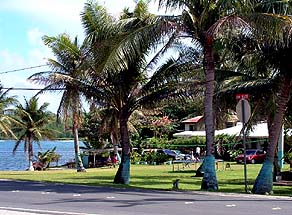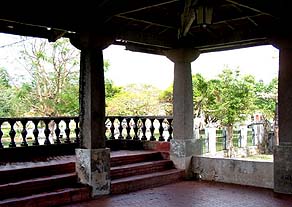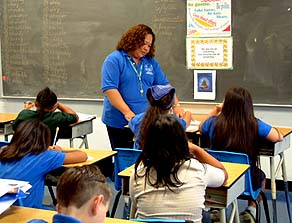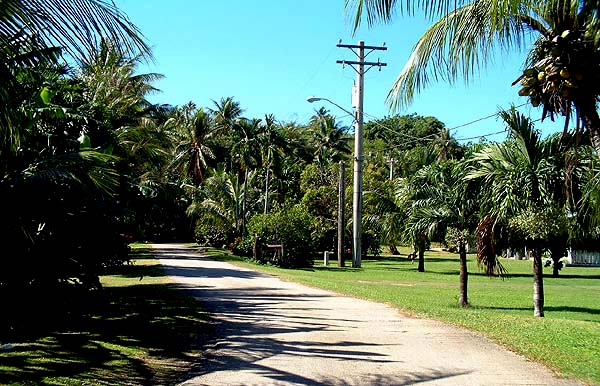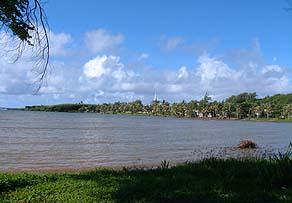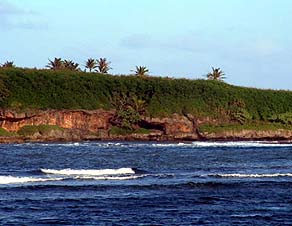 |
 |
 |
 |
||||
|
|
|
|
|
|
|
|
|
|
|
|||||||
|
|
|
|
|
|
As we depart Inarajan, we ask our guides to share their final thoughts with us, reflecting on all that has been presented here regarding Inarajan, and on the future of Guam as a whole.
|
||
|
|
||
Bill Paulino: "I would say that right now I'm really enjoying it here, the peace and tranquility that I see in Inarajan. And what makes it like that? People are very cohesive, the family is still very, very intact. We know each other. I don’t have to get very far with that kind of help from the families and I like to see that. "Development may come in and may change the way it is, but I hope that the kind of experience that I have becomes a legacy for my children and my children's children to come, generations to come. I hope to see that."
|
A tranquil setting by Inarajan Bay.
|
|
|
"You look at our history and it tells you that during the Spanish - Chamorro wars, we had quite a big population here with 100,000 Chamorros. And it boiled down to about 5,000. Who did they kill at first? The men — they wanted to get rid of the men. So the women started inter-marrying, first with the Spaniards. "But one thing that they decided, the women made up their minds to ensure that their children spoke the language, and I believe because of that, because of the commitment to the language and the culture of the Chamorro people, it's still alive today."
|
|
|
|
“We have a civilization that is over 3,000 years old," Rufo says. "and then we have a new civilization that was imposed on us three-hundred sixty-something years ago. And then 104 years ago, we had another civilization come in. And these are alien civilizations to us. But throughout this period, we continued to retain not our entire cultural identity, but most of our cultural identity. We have resisted a lot of the changes. But now I see the ‘melting-pot’ concept, and the process of assimilation has speeded up."
|
||
|
|
||
|
|
“See, the language is practically lost. And the language is how you convey your cultural practices. There are times when I want to tell you something, but I can only convey it in Chamorro, because I cannot translate it into English, there is no English equivalent to the concept. “Chamorro is being taught in schools, but I don’t think that there is any seriousness about it. We’ve discussed the creation of a Chamorro immersion school. I know that this is being done in a lot of places: in Europe, in the United States the American Indians are doing it; the Hawaiians are doing it. In New Zealand, the Maori are doing it."
|
"Another part of the problem is the loss of the traditional knowledge. I think the elders are considered by the younger generation to be not educated. So the tendency is to ignore their knowledge. But that’s knowledge gained through years of experience. “So we have to find a medium, where our people can exist and compete in the modern world, yet know to retain the knowledge, the culture, the language, and retain their identity."
|
Tan Floren at Gef Pa'go.
|
|
|
|
The end of the village, by Fama‘åyan.
|
Anne Hattori: "There's a lot of questioning now about what does it take, how do you qualify. Because young people are trying to form their own identities and figure out who they are, it's very hard on them to feel like 'Do I have to meet up with some criteria because I don't live in the southern villages or because I don't do this or that'?"
|
||
|
|
||
|
"I think this is something a lot of kids are struggling with. And in part things like the revival of Chamorro dance has been fueling the anxiety, because there are people that are saying 'Do I have to do that to be a Chamorro?' "Change is a natural part of being human but you don't necessarily have to sacrifice who you are. Being Chamorro today is of course going to be different from what it was 400 years ago, but it doesn't mean you're not Chamorro."
|
|
|
|
|
Sunset off Hagåtña.
|
Ben Meno: “One thing about our people, we teach our younger generation and our people: respect supersedes everything. You have to respect anyone, and everyone, whether they’re black, red, blue, whatever the color of their skin, no matter what religion they come from, or believe. Respect is something that we teach our children. If there is respect, there is dignity."
|
||
|
|
||
|
“These are very precious gifts in life that we should appreciate: we take it for granted that the sun is going to come out and shine on us, and the wind will blow so we can breathe and feel it, and the rain, so we can feel the coldness. We all take these for granted. But it means a great deal, a great deal. “I know that we’re all going to leave this world, whether we like it or not. The point is, giving the information to the generations is extremely important: on where we come from, who we are, what we are, and what we should teach our future generations."
|
|
|
|
“Sharing, you share your vision, what you see around the world — I’m doing it now. And that’s what every one of us should do, we share the knowledge. Because knowledge has no boundary. Knowledge has a beginning, but is has no end. You know you are going to die, so make use of it between your birth until you go to your grave. Use it, share it. "The song that I would teach you would always be there, and you would always know it, and my advice is to pass it down. Pass down the tradition and the culture."
Adios, asta ki umali'e' hit ta'lo!
|
||
|
|
||
|
|
|
|
|
|

|
| Inarajan Home | Map Library | Site Map | Pacific Worlds Home |
|
|
|
|
|
|
|
|||
| Copyright 2003 Pacific Worlds & Associates • Usage Policy • Webmaster |
|||

